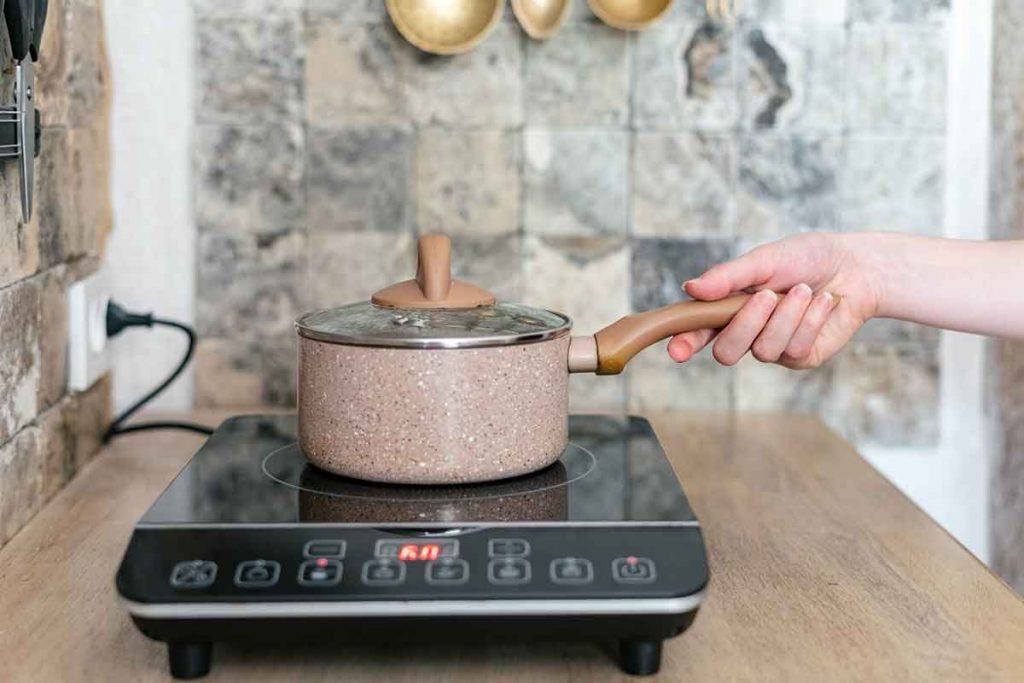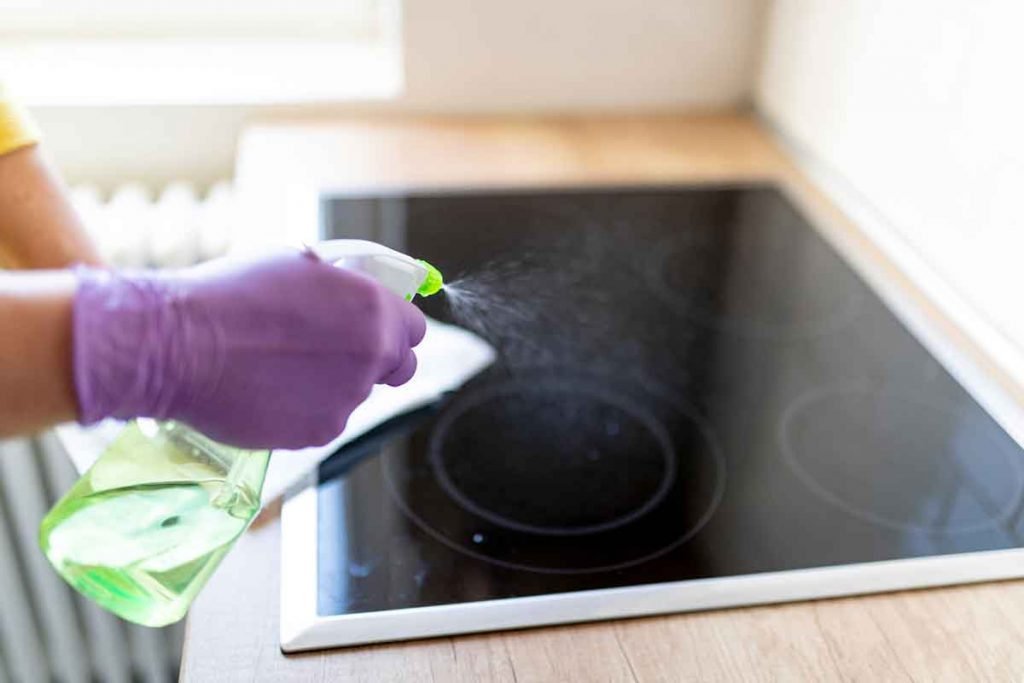Yes, non-stick pans work with induction cooktops.
Non-stick pans are very popular today. Most people are switching to this type of cookware because their coating prevents food from sticking to the bottom and makes them easier to clean. And the benefits compound when you couple non-stick cookware with induction cooking. How so? With an induction cooker in the mix, you can also cut energy consumption by up to 10%!
That said, allow me to point out something crucial. Not all non-stick pans are induction-friendly. So, if you have a non-stick pan that doesn’t work on your cooktop, don’t fret. This article will help you understand why your induction hob isn’t compatible with some non-stick pans.
Read our review on Best Cookware Sets for Induction Cooktops for the perfect option:
Why is My Non-Stick Pan Not Working on Induction?
If your non-stick pan isn’t working with an induction cooktop, the following issues might be to blame:
1. Material Compatibility
A non-stick pan can only work with an induction stove if its base is made from an induction-compatible material like cast iron, nickel, enameled iron, or stainless steel. The best material is stainless steel since it’s magnetic and ferrous, two crucial properties for induction-friendly cookware.
If your non-stick pan isn’t working on an induction hob, the first suspect should be the material. Check if it’s made entirely of an incompatible material like aluminum, copper, ceramic, or glass. If the material isn’t induction-friendly, switch to a compatible pan or use a converter disc.
2. Pan Size
When it comes to induction cooking, the size of your cookware matters. To effectively prepare a meal with an induction hob, you need to use a pan with a base that matches or is close to the size of the cooking zone. Don’t use cookware that’s either too big or too small. Why?
If you use cookware with a small base, the cooktop might fail to detect it and refuse to activate. So here’s the answer to your question. If your non-stick pan is not working, check if it’s smaller than the induction hob’s cooking zone. On the other hand, although a cooktop is likely to sense a larger pan, the size might negatively impact the appliance’s energy efficiency.
3. Poor Cookware Condition
A good non-stick pan is supposed to last 2-3 years. After that, it’s likely to show signs of wear, like flaking, chipping, and peeling. Moreover, the longer you use a pan, the more it’s exposed to issues like bending and deformation.
If you have an old non-stick pan that won’t work on an induction cooktop, assess its condition. Watch out for significant issues like a warped or deformed base. That is crucial because if a pan’s bottom is bent or deformed, it might fail to contact the induction hob’s cooking surface properly.
How To Tell if a Pan is Induction-Compatible

Do you wonder if your non-stick pan is induction-compatible? You can test its compatibility by following these steps:
Step 1: Inspect the Pan
Before doing anything else, inspect your pan. Most of my pots and pans have stickers and markings with “induction ready” or “induction compatible”. Check if your non-stick pan has anything on it that proves it’s induction-ready or compatible. If you see no sticker or marking, check the packaging. If you don’t find anything useful, proceed to step 2.
Step 2: Test the Pan With a Fridge Magnet
If nothing on your pan or its packaging shows induction compatibility, test the cookware for magnetism. Simply grab a magnet from your fridge, flip the pan over, and place the magnet against its base. If your cookware is induction-ready, the magnet should stick.
What Cookware Can Not Be Used on an Induction Cooktop?
Not all pots and pans are induction-ready. If you have any of the following cookware, don’t expect it to work on an induction cooktop:
- Pots and pans made of non-magnetic stainless steel.
- Aluminum pots and pans
- Ceramic pots and pans
- Copper pots and pans
- Round-bottomed woks and pans
- Glass cookware and bakeware
But generally, here’s a rule of thumb:
| Cookware Material | Induction Compatibility |
|---|---|
| Aluminum | Not compatible – does not contain iron |
| Copper | Not compatible – does not contain iron |
| Glass | Not compatible – does not contain iron |
| Stainless steel (some types) | May not be compatible – depends on iron content |
| Cast iron | Compatible – contains iron |
| Enamel-coated cast iron | Compatible – coating does not affect induction |
Note that pots and pans made from the mentioned materials can work on induction cookers if they have a magnetized base. But if not, they won’t activate a cooktop’s cooking zone or heat up.
If your cookware doesn’t work with an induction cooktop, don’t worry – there are heat diffusers or induction plates you can use with your stove. Here are three recommendations:
Read our review on the best induction cooktop converter plates to allow you to use any cookware.
Conclusion
If you have a non-stick pan that refuses to work on an induction cooker, you have enough reason to suspect material incompatibility. That is because only magnetic materials are compatible with induction cooking technologies. So check if your pan is made entirely from an induction-friendly material like stainless steel or if it has a magnetic base.
A non-stick pan may also fail to work on an induction cooktop if it’s too small, warped, or bent. Keep an eye out for such issues.
Common Questions
What should you look for when buying a nonstick pan for induction?
Check that the pan specifies induction compatibility. Look for ones with an embedded magnetic stainless steel or cast iron plate on the bottom. Avoid nonstick pans made solely of aluminum or copper without an induction-suitable base.
Why do some nonstick pans not work on induction?
If the nonstick pan does not have a magnetic base, the induction cooktop cannot create enough heat through the pan to cook. Induction requires cookware with iron content in direct contact with the cooking surface.
Which nonstick coating works best for induction cooking?
PFOA-free ceramic nonstick coatings are durable, safe, and recommended for induction. Other good options are titanium-reinforced or diamond-infused nonstick finishes. Avoid older Teflon coats as they may get damaged by induction heat.
What are the benefits of using nonstick pans on induction cooktops?
Nonstick pans allow easy slide release of foods. Coupling nonstick with induction provides superior temperature control and efficient cooking. The slick surface also makes nonstick pans easy to clean after use on an induction cooktop.
How can you avoid damaging nonstick pans on induction?
Use lower or medium heat settings only. Rapid heating on high can degrade the nonstick over time. Avoid metal utensils that can scratch the coating. And ensure the pan size matches the induction burner.
Do you need special care or maintenance for nonstick-induction pans?
Hand wash gently with non-abrasive sponges. Avoid very high heat or aggressive scouring to prevent damaging the nonstick coating. Some nonstick pans may be induction-suitable but high-maintenance.



